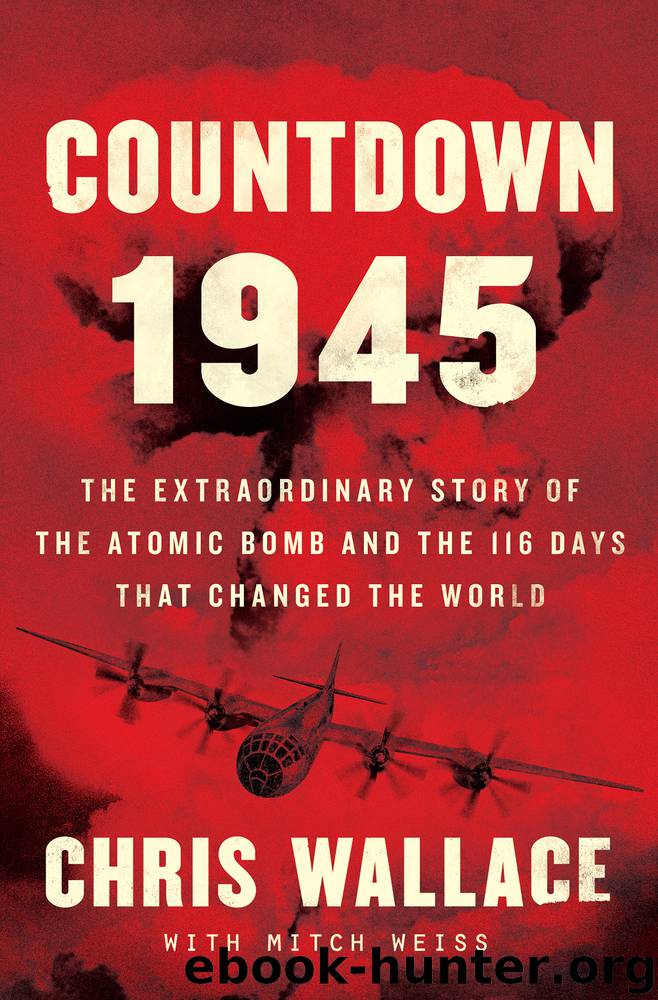Countdown 1945: The Extraordinary Story of the Atomic Bomb and the 116 Days That Changed the World by Chris Wallace & Mitch Weiss

Author:Chris Wallace & Mitch Weiss
Language: eng
Format: epub
Publisher: Avid Reader Press / Simon & Schuster
Published: 2020-06-08T23:00:00+00:00
COUNTDOWN: 12 DAYS
July 25, 1945
Los Alamos, New Mexico
They partied in the streets of Los Alamos when they got the news of the Trinity test at Alamogordo. Whiskey flowed, bongo drums sounded, and scientists and technicians danced through that first great day.
As time passed, eyewitnesses excitedly recounted what they’d seen and felt that morning in the desert. A sudden flash, a searing bright light, followed by an enormous ball of fire that changed from yellow to orange to red as it grew. A mushroom-shaped cloud that climbed thousands of feet in the sky. A massive bang followed by the rumble of man-made thunder that could be heard for miles.
The scientists, engineers, and soldiers had been working so long and so hard, they had to talk about it. These were momentous times, and they’d seen something utterly marvelous. Led by Oppenheimer, the man they considered the genius of the age, they’d combined their efforts to unlock a secret of the universe.
And then the euphoria died down.
Some of the scientists began to face the stark truth: they’d created a means for mass destruction. In all likelihood, the device they’d so enthusiastically created would soon incinerate a Japanese city full of men, women, and children.
Work slowed at Los Alamos. Scientists began openly debating the morality of using atomic weapons. Kistiakowsky, the chemist who helped develop a specialized explosive charge for the nuclear weapon, said the new bomb was no worse than the ongoing firebombing of Japanese cities. Others argued that it was a trade-off: a Japanese population would die so another population of Allied soldiers wouldn’t have to.
Physicist Robert Wilson was having a particularly difficult time. “It’s a terrible thing we made,” he told a colleague. Others felt guilty for waiting so long to take a moral position—they should have spoken up with Szilard and Franck. Some believed there was still time to convince military leaders not to use the atomic bomb without first warning the Japanese.
Oppenheimer had battled depression for most of his life, and he felt the familiar darkness closing in. In boardrooms with military leaders hashing out details of Japanese target cities, Oppenheimer imagined what would happen on the ground beneath the explosion, how the holocaust would unfold over city blocks and neighborhoods. His secretary, Anne Wilson, saw the change. He walked from his house to the Technical Area, mumbling, “Those poor little people. Those poor little people.” She knew what he meant.
But somehow Oppenheimer was able to compartmentalize his second thoughts. He continued working with Groves to ensure the explosion delivered maximum psychological impact on the Japanese. General Thomas Farrell and Colonel John Moynahan, two officers in charge of the bombing of Hiroshima, were given a list of instructions.
“Don’t let them bomb through the clouds or through an overcast,” Oppenheimer wrote. “Got to see the target… Of course, they must not drop it in rain or fog.… Don’t let them detonate it too high… or the target won’t get as much damage.”
Oppenheimer’s monster was almost loose. Unlike Dr. Frankenstein, there was no way to destroy it now.
Download
This site does not store any files on its server. We only index and link to content provided by other sites. Please contact the content providers to delete copyright contents if any and email us, we'll remove relevant links or contents immediately.
| Africa | Americas |
| Arctic & Antarctica | Asia |
| Australia & Oceania | Europe |
| Middle East | Russia |
| United States | World |
| Ancient Civilizations | Military |
| Historical Study & Educational Resources |
The Radium Girls by Kate Moore(11975)
100 Deadly Skills by Clint Emerson(4880)
Rise and Kill First by Ronen Bergman(4739)
The Templars by Dan Jones(4656)
The Doomsday Machine by Daniel Ellsberg(4451)
The Rape of Nanking by Iris Chang(4169)
Killing England by Bill O'Reilly(3969)
Hitler in Los Angeles by Steven J. Ross(3923)
Stalin by Stephen Kotkin(3918)
12 Strong by Doug Stanton(3527)
Hitler's Monsters by Eric Kurlander(3291)
Blood and Sand by Alex Von Tunzelmann(3167)
The Code Book by Simon Singh(3139)
Darkest Hour by Anthony McCarten(3096)
The Art of War Visualized by Jessica Hagy(2974)
Hitler's Flying Saucers: A Guide to German Flying Discs of the Second World War by Stevens Henry(2731)
Babylon's Ark by Lawrence Anthony(2649)
The Second World Wars by Victor Davis Hanson(2502)
Tobruk by Peter Fitzsimons(2479)
